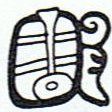3. Sun has become completely dried out, he has become a skeleton, and in the form of One Hunaphu he 'spits into the right hand' of the maiden Blood Moon. The result should be that she will grow. The story of life moves on from Sun to Moon. The first night of Waxing Moon is Ohiro, a name we have encountered already. It was when I said how useful it was to have a dried old calabash as a carrier of sweet water on a sea voyage: ... Within a few days the canoe was loaded with provisions. Great fish baskets were made of bamboo, filled with many kinds of fish, and attached to the outside of the canoe so as to be in the water. Bamboos and gourds were filled with water and stowed away on board, and there were fe'i, bananas, taro, and mahi (fermented breadfruit) in abundance. A bed of sand and stones was made upon the deck, upon which to make a fire for cooking the food, and soon Hiro was ready to go to sea ... Hiro was the name of this mythic great double canoe. Moon can be likened to a great double canoe (with one hull being Waxing Moon and the other Waning Moon). And the islet Mokuola lies in the Bay of Hilo, which we can transcribe into Haga Ohiro on Easter Island. With Mokuola (the 'living land') personifying Spring Sun we have arrived at the border line between land and sea at the end of his life journey. Moon is the double-canoe which waits for him:.
There is a haga rave sign at left in Eb7-10. Presumably this glyph 'is' Haga Ohiro, where the season of prolific spring growth is ending. The glyph type at right is niu, the palm which has hard nuts looking like death personified: ... When viewed on end, the endocarp and germination pores give the fruit the appearance of a coco (also Côca), a Portuguese word for a scary witch from Portuguese folklore, that used to be represented as a carved vegetable lantern, hence the name of the fruit ... In Maya-land the month was Uniu (the Moon type of niu, I guess), or in Yucatec Kankin ('skeleton ribs'):
Niu is the tree which grows from the 'coconut', the dry old head of Spring Sun. In Eb7-8 we can guess the 'branch' at left represents the Mokuola season - it has only one crescent sign (Sun has only one limb) - while the 'branch' at right has 2 (the number of Moon). |


